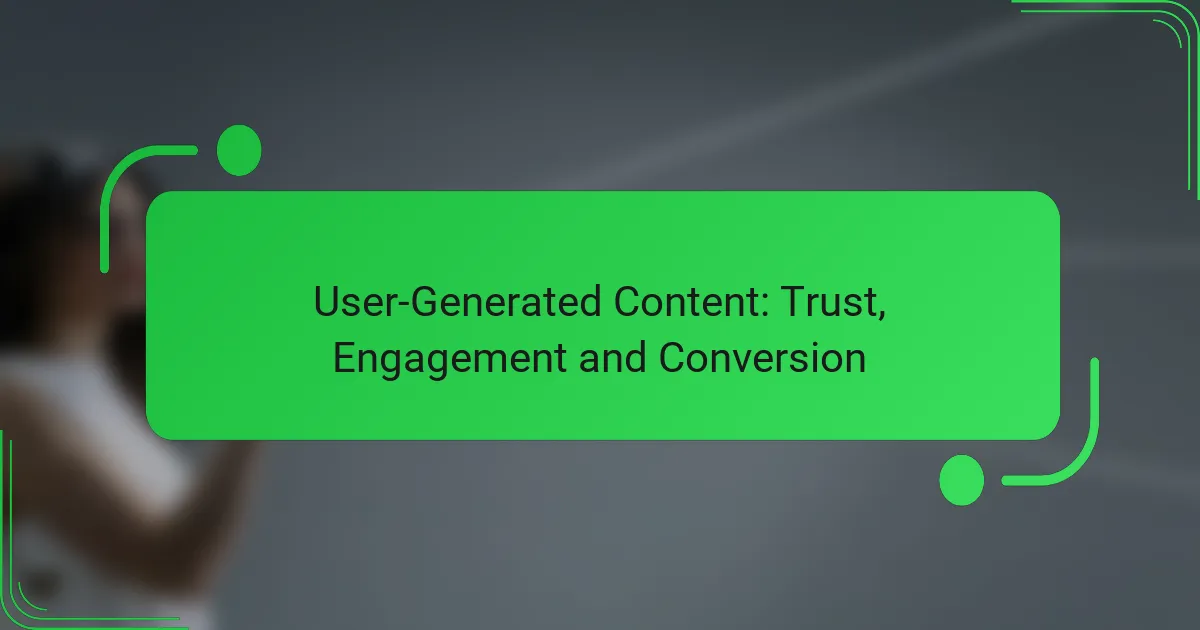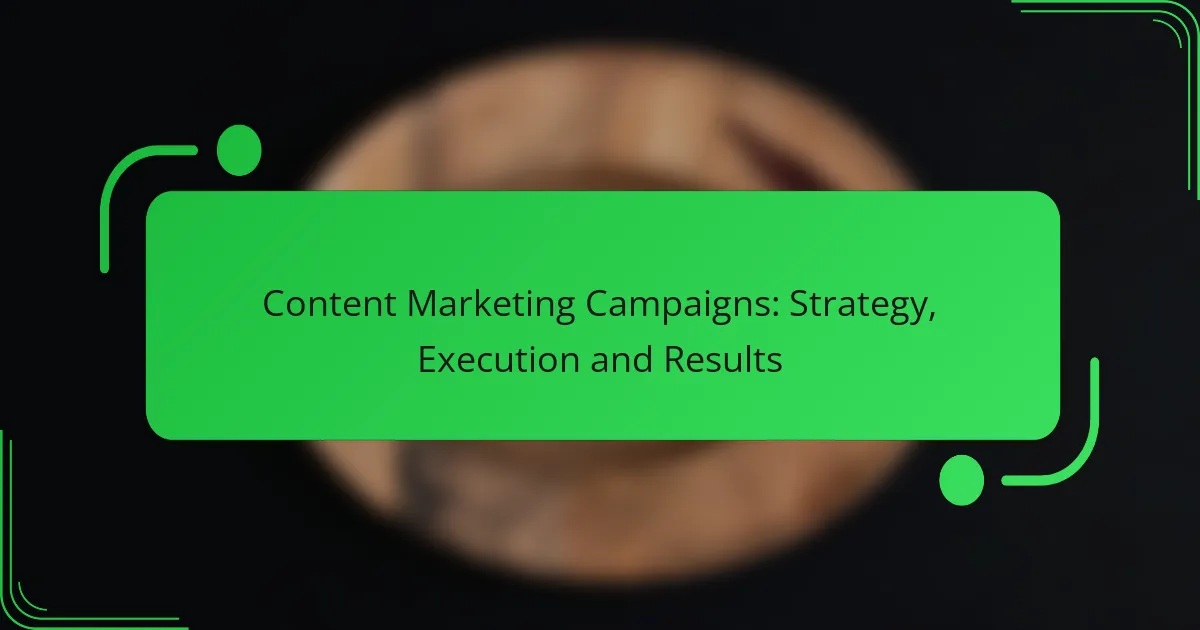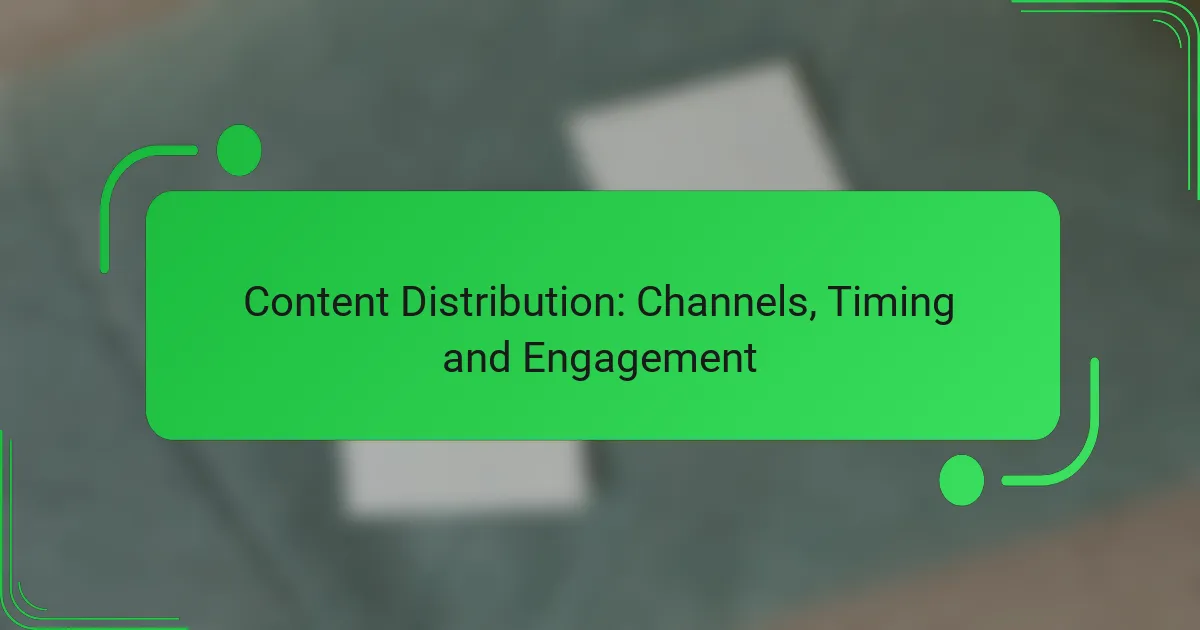User-generated content (UGC) plays a crucial role in building trust and engagement for brands by highlighting genuine experiences from real customers. This authentic representation not only enhances a brand’s credibility but also fosters a sense of community, ultimately leading to increased conversion rates as potential buyers feel more confident in their purchasing decisions.
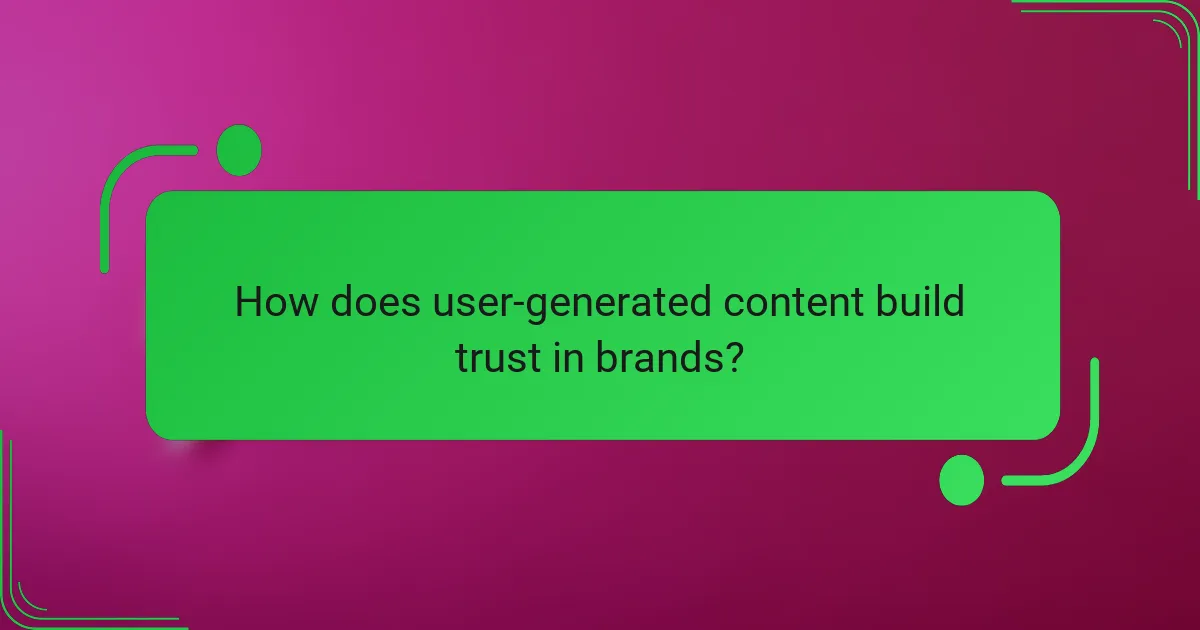
How does user-generated content build trust in brands?
User-generated content (UGC) fosters trust in brands by showcasing authentic experiences from real customers. This type of content acts as a powerful endorsement, helping potential buyers feel more confident in their purchasing decisions.
Authenticity through real customer experiences
Authenticity is crucial for building trust, and UGC provides genuine insights into customer experiences. When potential customers see real people using a product, it creates a relatable connection that polished marketing often lacks. For instance, a video review from a satisfied customer can resonate more than a professional advertisement.
Brands can encourage UGC by creating campaigns that invite customers to share their stories, such as photo contests or hashtag challenges. This not only generates content but also strengthens the community around the brand.
Social proof and peer influence
Social proof is a psychological phenomenon where individuals look to the actions of others to guide their own behavior. UGC serves as social proof, demonstrating that others trust and enjoy a brand’s products. For example, seeing numerous positive reviews or user photos can significantly influence a potential buyer’s decision.
Brands can leverage social proof by prominently displaying UGC on their websites and social media channels. Highlighting customer testimonials or showcasing popular products can enhance credibility and encourage new customers to make a purchase.
Transparency in feedback and reviews
Transparency in customer feedback is essential for building trust. UGC often includes both positive and negative reviews, which can provide a balanced view of a product. This openness shows that a brand values honest opinions and is willing to address concerns, further enhancing trust.
To promote transparency, brands should actively engage with customer reviews, responding to both praise and criticism. This interaction not only demonstrates accountability but also fosters a sense of community, encouraging more customers to share their experiences.

What are the engagement benefits of user-generated content?
User-generated content (UGC) significantly boosts engagement by fostering authentic interactions and connections among users. By leveraging content created by customers, brands can enhance their online presence and create a more vibrant community around their products or services.
Increased interaction on social media platforms
User-generated content drives higher interaction rates on social media, as users are more likely to engage with posts that feature real customers and their experiences. This can lead to increased likes, shares, and comments, amplifying brand visibility.
For instance, brands that showcase customer photos or testimonials often see engagement rates that are several times higher than standard promotional posts. Encouraging users to tag the brand in their posts can create a continuous cycle of interaction.
Enhanced community building and loyalty
UGC fosters a sense of community among users, as it encourages them to share their experiences and connect with others who have similar interests. This communal aspect can lead to stronger brand loyalty, as customers feel more invested in a brand that values their contributions.
Brands can enhance this loyalty by featuring user stories in newsletters or on their websites, creating a sense of belonging. Regularly highlighting user-generated content can make customers feel appreciated and more likely to return.
Encouragement of user participation and creativity
By inviting users to contribute their content, brands can stimulate creativity and participation. Campaigns that encourage users to share their own ideas or creations can lead to a wealth of diverse content that reflects the brand’s values.
For example, running contests or challenges that ask users to submit photos or videos can generate excitement and engagement. Providing clear guidelines and incentives can help maximize participation while ensuring that the content aligns with the brand’s image.
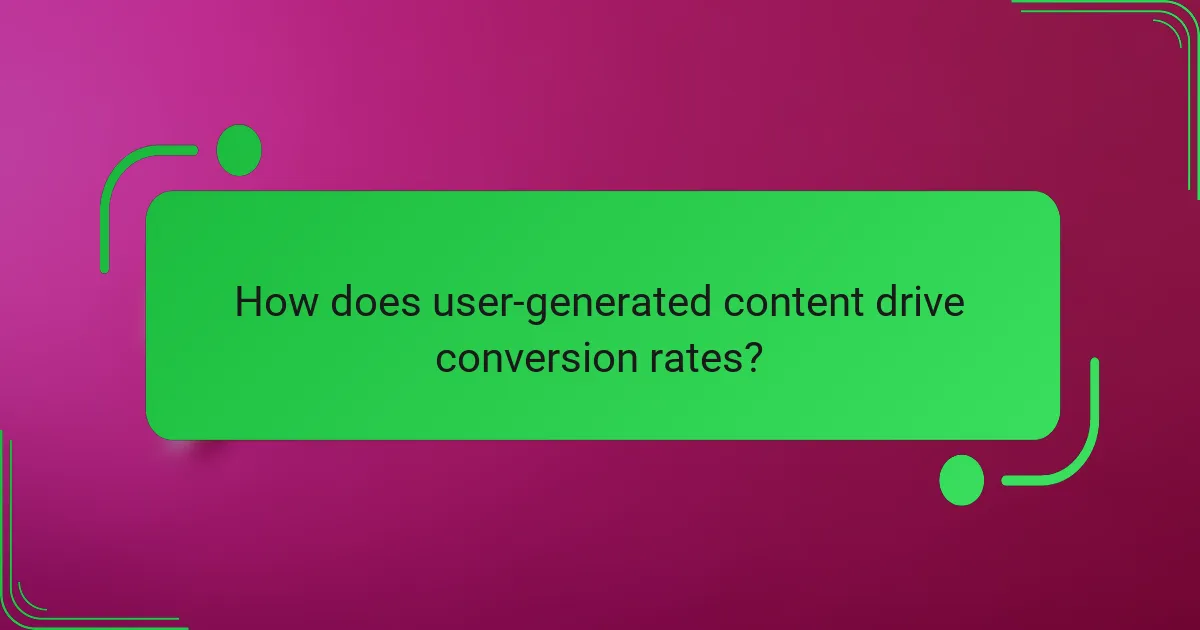
How does user-generated content drive conversion rates?
User-generated content (UGC) significantly boosts conversion rates by fostering trust and engagement among potential customers. When consumers see authentic experiences shared by others, they are more likely to make a purchase, as this content resonates with their needs and preferences.
Higher conversion through relatable content
Relatable content, such as photos and testimonials from real users, can enhance a brand’s appeal. When potential buyers encounter UGC that reflects their own experiences or aspirations, they feel a stronger connection to the product. This emotional engagement often translates into higher conversion rates.
Brands can encourage UGC by creating campaigns that invite customers to share their stories or experiences. For example, a clothing retailer might run a contest where customers post photos wearing their products, increasing both visibility and relatability.
Influence of reviews on purchasing decisions
Reviews play a crucial role in shaping purchasing decisions, with many consumers relying on them before making a commitment. Positive reviews can significantly increase the likelihood of conversion, while negative feedback can deter potential buyers. Research indicates that a high percentage of consumers trust online reviews as much as personal recommendations.
To leverage reviews effectively, businesses should actively encourage satisfied customers to leave feedback. Displaying these reviews prominently on product pages can help build credibility and instill confidence in prospective buyers.
Case studies of successful campaigns
Numerous brands have successfully utilized UGC to enhance their conversion rates. For instance, a well-known cosmetics brand launched a campaign encouraging users to share makeup looks on social media, resulting in a substantial increase in sales and brand engagement.
Another example is a travel company that featured customer photos and testimonials on its website. This strategy not only showcased real experiences but also improved trust, leading to a noticeable uptick in bookings. These case studies illustrate the tangible benefits of integrating user-generated content into marketing strategies.
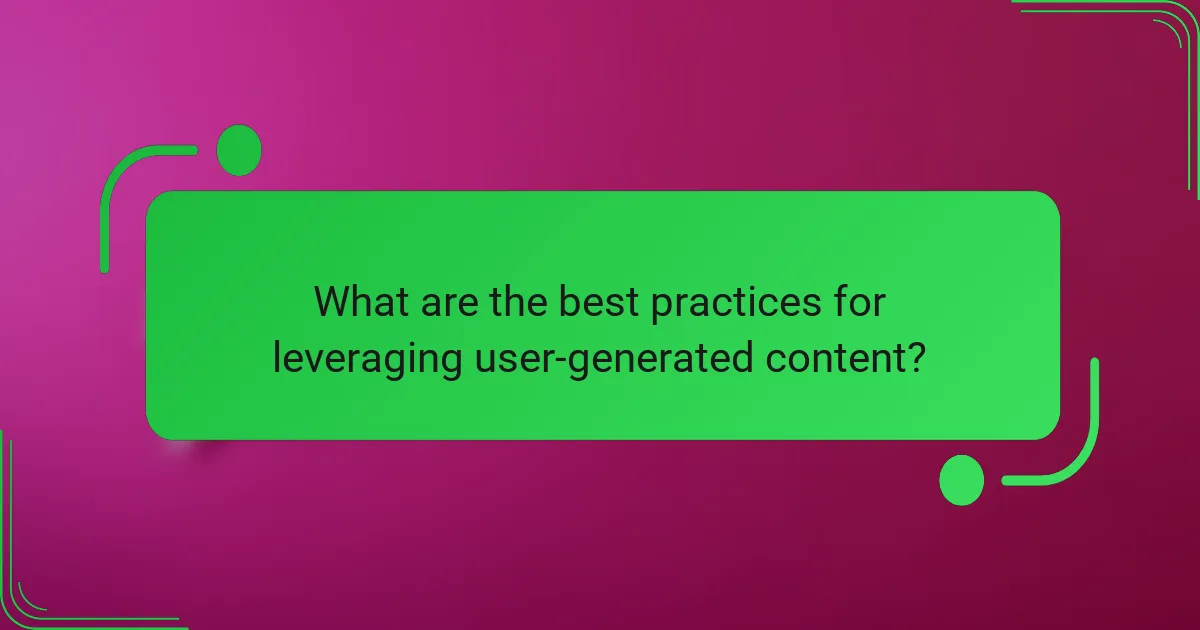
What are the best practices for leveraging user-generated content?
To effectively leverage user-generated content (UGC), brands should focus on encouraging submissions, moderating the content, and integrating it into their marketing strategies. These practices enhance trust, engagement, and conversion rates by showcasing authentic customer experiences.
Encouraging content submissions through incentives
Offering incentives is a powerful way to encourage users to submit content. Consider providing discounts, exclusive access, or entry into contests as rewards for sharing their experiences. This not only motivates participation but also fosters a sense of community among users.
Make the submission process easy and accessible. Utilize social media platforms, branded hashtags, or dedicated submission forms on your website to streamline contributions. Clear guidelines on what type of content you are looking for can also help users feel more confident in their submissions.
Moderating and curating user content
Moderation is essential to ensure that the user-generated content aligns with your brand values and quality standards. Establish clear criteria for acceptable content and actively monitor submissions to filter out inappropriate or irrelevant material.
Curating the best submissions can enhance your brand image. Highlight high-quality content on your website or social media channels, giving credit to the creators. This not only showcases your customers but also encourages others to contribute, knowing their work may be featured.
Integrating user content into marketing strategies
Incorporating user-generated content into your marketing strategies can significantly boost authenticity and engagement. Use UGC in email campaigns, social media posts, and product pages to provide real-life examples of how customers use your products or services.
Consider creating a dedicated section on your website for user content, such as testimonials or galleries. This not only enhances your site’s credibility but also encourages visitors to explore more, potentially leading to higher conversion rates.

What metrics should be used to measure user-generated content success?
To effectively measure the success of user-generated content (UGC), focus on engagement rates, conversion tracking, and sentiment analysis. These metrics provide insights into how well UGC resonates with your audience and its impact on business outcomes.
Engagement rates across platforms
Engagement rates indicate how actively users interact with your UGC. This can include likes, shares, comments, and overall reach across various platforms such as social media, blogs, and forums. A higher engagement rate often correlates with content that resonates well with your audience.
To measure engagement, track metrics like the number of interactions relative to the total views or impressions. For example, a post with 500 likes on 5,000 views has a 10% engagement rate. Aim for engagement rates in the low to mid-teens for optimal performance.
Conversion tracking from user content
Conversion tracking assesses how effectively UGC drives desired actions, such as purchases or sign-ups. Use tools like Google Analytics to attribute conversions to specific pieces of user-generated content. This helps determine which content types are most effective in influencing customer behavior.
Consider setting up unique tracking links for different UGC campaigns to monitor performance. A conversion rate of 2-5% is typically considered good for UGC, but this can vary based on industry and audience engagement.
Sentiment analysis of user feedback
Sentiment analysis evaluates the emotions and opinions expressed in user-generated content, providing insight into customer perceptions. Tools like natural language processing can help analyze comments, reviews, and social media posts to gauge overall sentiment towards your brand.
Focus on identifying positive, negative, and neutral sentiments in user feedback. A high percentage of positive sentiment (above 70%) generally indicates strong brand loyalty and satisfaction, while negative sentiment may highlight areas needing improvement. Regularly review sentiment trends to adapt your content strategy effectively.
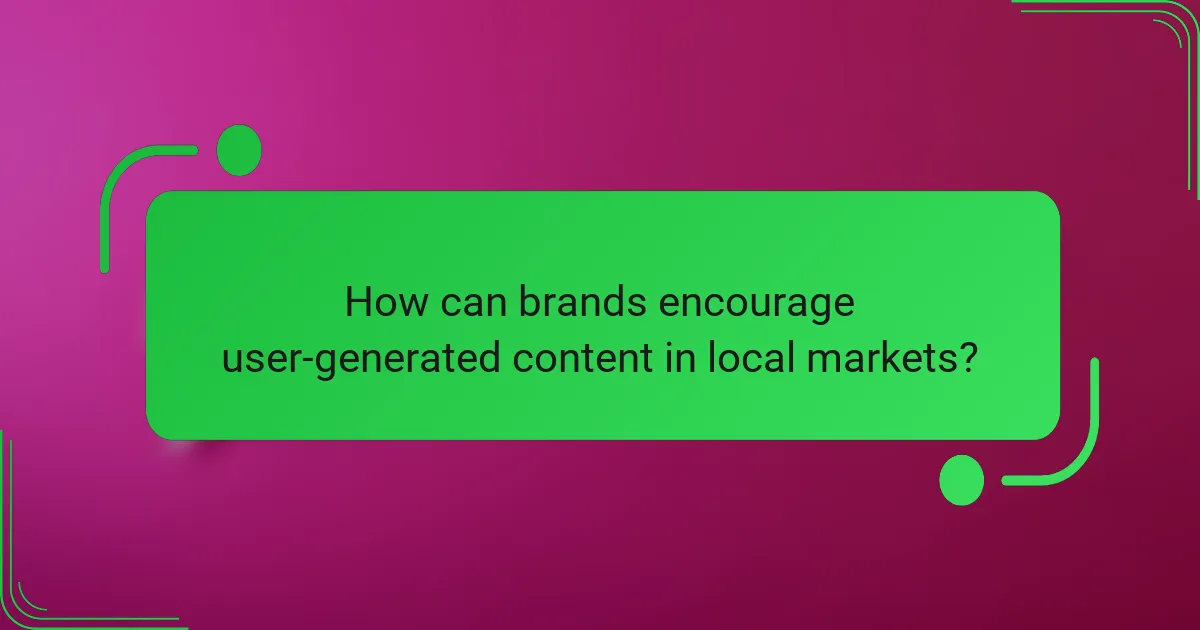
How can brands encourage user-generated content in local markets?
Brands can encourage user-generated content (UGC) in local markets by creating engaging campaigns that resonate with the community’s unique culture and preferences. This involves leveraging local influencers, hosting events, and tailoring messaging to reflect local values and interests.
Localized campaigns targeting specific communities
Localized campaigns are essential for connecting with specific communities. Brands should research local interests and trends to create content that feels relevant and authentic. For example, a food brand might run a contest inviting locals to share their favorite recipes using their products, fostering a sense of community involvement.
When designing these campaigns, consider incorporating local languages and cultural references to enhance relatability. This approach not only encourages participation but also strengthens brand loyalty among local consumers.
Collaborations with local influencers
Partnering with local influencers can significantly amplify a brand’s reach and credibility. Influencers who understand the local market can create content that resonates with their audience, encouraging their followers to engage with the brand. For instance, a fashion brand could collaborate with a local style influencer to showcase how their products fit into everyday life in that area.
When selecting influencers, prioritize those with authentic engagement over sheer follower count. Micro-influencers often have more dedicated audiences and can drive higher levels of trust and interaction with UGC.
Utilizing local events for content generation
Local events provide a rich opportunity for brands to generate user-generated content. By sponsoring or participating in community events, brands can engage directly with consumers, encouraging them to share their experiences online. For example, a beverage company might set up a booth at a local festival, inviting attendees to post photos with their products using a specific hashtag.
To maximize impact, brands should create interactive experiences at these events, such as photo booths or contests, that incentivize attendees to create and share content. This not only boosts UGC but also enhances brand visibility within the community.
